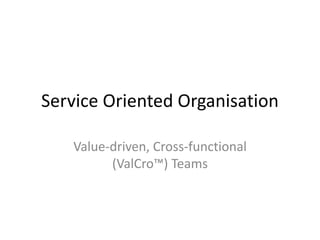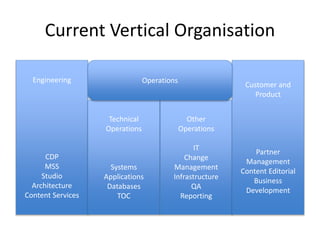Service oriented organisation
- 1. Service Oriented Organisation Value-driven, Cross-functional (ValCroŌäó) Teams
- 2. Purely traditional, vertical reporting lines meanŌĆ” ŌĆó There are skills not being utilised in some teams ŌĆó Other teams are then wasting time learning these skills ŌĆó We only do ad hoc value stream work; and thenŌĆ” ŌĆó Traditional teams are constantly being interjected by value driven streams of work anyway ŌĆó That reliance on developers to do Ops work is still too great (AMI Armageddon) ŌĆó There is duplication of work and overlapping reports
- 3. Current Vertical Organisation Engineering CDP MSS Studio Architecture Content Services Technical Operations Systems Applications Databases TOC Other Operations IT Change Management Infrastructure QA Reporting Customer and Product Partner Management Content Editorial Business Development Operations
- 4. Responsibility Groups ŌĆó Content/Assets ŌĆó Customer management ŌĆó Product management ŌĆó Software Engineering ŌĆó Architecture ŌĆó Technical Operations ŌĆó Business Operations
- 5. Updated Vertical Responsibilities Software Engineering Asset Ingestion Dev CDP MSS Studio Architecture Operations Engineering Systems Applications Infrastructure Databases Tech Prob Mgmt Technology Mgmt Business Operations IT Facilities Change Mgmt QA Reporting Cost Mgmt Customer and Product Customer Mgmt Asset/Ingestion Mgmt Business Dev Product Mgmt
- 6. Example ValCro Teams ŌĆó Customer Services: PMs, TOC ŌĆó Technical Problem Management: TOC, ASG, PMs, Eng ŌĆó Quality Services: QA, Change Management and Applications ŌĆó Asset Management: Editorial, Ingestion Management (GMB & CS support), Reporting ŌĆó Content Delivery (Software Engineering): Reporting, CS dev and CDP ŌĆó Internal and Microsoft Services: IT, Databases and Infrastructure ŌĆó Data Services: Databases, Reporting, QA ŌĆó Platform Services: Systems, Infrastructure, Applications (including David S)
- 8. ValCro Service Stack Platform Services Data Services IT/Microsoft Services Software Engineering (e.g. Content Delivery) Asset Management Quality Services Technical Problem Management Customer Services and Incident Management IT Security
- 9. Example ValCro Team Responsibilities ŌĆó Platform Services: Complete system deployment, CMDB, System Performance Engineering (non- application improvements and data analytics), System security ŌĆó Data Services: data modelling, database technologies, database administration, BI ŌĆó Asset Management: Content ingestion, asset supplier relationships, curation, royalty reporting ŌĆó ŌĆ”
- 10. ValCro Teams MeanŌĆ” ŌĆó Better utilisation of people and skills ŌĆó Increased efficiency ŌĆó Increased opportunity for engineers and managers to learn ŌĆó Reduced dependencies and blocker ŌĆó Greater focus on delivering things of real value ŌĆó Better validation of goals and results
- 11. Remaining Questions ŌĆó Do architecture report into Phil directly, maybe as R&D and then feed into Software Engineering and Operations Engineering ŌĆó Current Dev Leads should become known as Tech Leads ŌĆó Current Tech Team should become known as Tech Management ŌĆó Where does value streams come from? ŌĆō Tech Mgmt: business project work (this is current Tech Team) ŌĆō Tech Leads: internal project work (this is the current Dev Leads) ŌĆō Problem Mgmt: unplanned work ŌĆó Who reports to who? ŌĆō I think reporting lines are traditional stack ŌĆō And ValCro teams are dual lead (I have some ideas on this) ŌĆō All weekly reports should probably be done on-line so people can collaborate on them together
Editor's Notes
- #5: Technical Operations (OS, middleware, technology management, Infrastructure, technical problem management) Business Operations (reporting, IT, change management, partner cost management and QA)
- #6: Operations Engineering name for two reasons: to make an infrastructure move more appealing and because Netflix have a department of the similar name and this always goes down well
- #7: Who services who. Not totally linear and needs better visualisation
- #10: Incomplete. Needs finishing
- #12: ValCro leads?: Customer Services (Me & Neal): PMs, TOC Technical Problem Management (Me & Ricardo/Daniel): TOC and PMs Quality Services (Neal & Steve): QA, Change Management and Applications┬Ā Asset Management (Neal & Alex): Editorial, Ingestion Management (GMB & CS support), Reporting Engineering ŌĆō E.g. New Content Services: Reporting, CS dev and CDP Internal and MS services (me & Steve): IT, Databases and Infrastructure Data services (Ricardo & Steve): Databases, reporting, QA Platform services (Adam & me): Systems, Infrastructure, Applications (including David S) Vertical (official) reporting lines?: Software Engineering: Dom Operations Engineering: Me Business Operations: Steve Customer and Product: Neal











